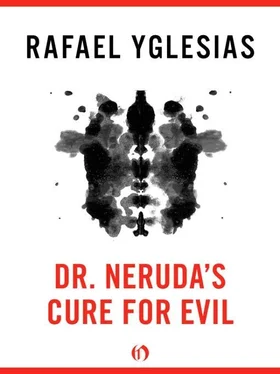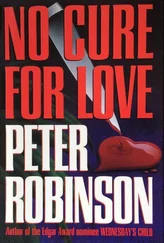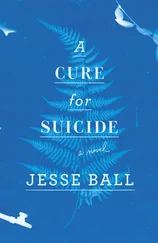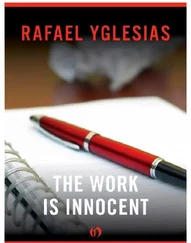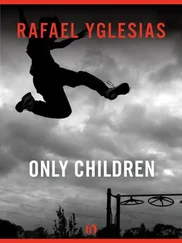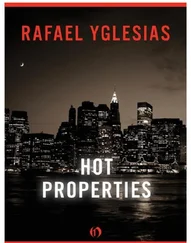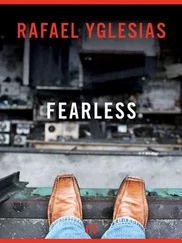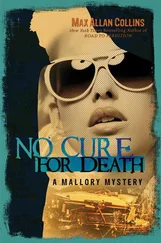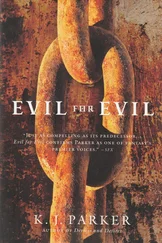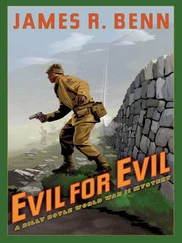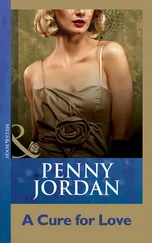“You mean, it rewards mediocrity,” I said.
The two clerks laughed and then covered their mouths as if I had broken a taboo.
The pro nodded and winked at me. He suggested I try the Wilson pro staff model, the closest to the width and thickness of the antique woodies. “This is what Stefan Edberg uses. It’s still got plenty of power,” he commented dryly.
Before making the trip downtown, I had stopped by Paragon on Union Square and, with some difficulty, bought plain white shorts. I couldn’t find a single plain shirt, so I wore one of my white polos. I had wrongly assumed the dress code at a place called the Wall Street Racquet Club would be white. In fact, I saw no other player in white. Copley showed up in a black and purple nylon matching outfit: black warm-up jacket with purple piping over a black shirt with a purple lightning bolt; black warm-up pants with zippers up the legs so they could be pulled off over his sneakers to reveal black shorts with purple piping.
“You changed already?” he said as a greeting.
“I came like this.”
“Do you have a change of clothes?” His tone was curt and commanding, as if I were his child.
For a yes, I showed him my bag.
“Here,” he gestured for me to give it to him. “I’ll put it in my locker.” He turned to the clerk. “We have Court One?”
“Yes, Mr. Copley,” the clerk said, although Stick hadn’t announced himself.
Copley disappeared into the lockers briefly. Returning, he led me onto the courts. When we passed through the rotating doors into the bubbles, my ears popped. Along with the roar of air-conditioning (outside the temperature had reached ninety-five) it felt as if we were in a jet. “How did it go with Andy?” Copley asked. He put his large tennis bag on a wood bench to the side of the net and opened it. He followed the serious tennis player’s equipment recommendation to the letter: he brought two identical wide-body racquets for alternating use to maintain equal string tension in case one broke during play. (It was no surprise, by the way, that he hadn’t offered me his spare racquet. Copley wasn’t the sort of person who would allow another man to handle his phallus, even a spare phallus.) I didn’t answer his question, apparently preoccupied by stretching my legs. He opened two cans of soft-surface balls for us to rally. I was nervous. I had played a lot of tennis as a teenager, but that was a long time ago. Stick watched me, bent over, moaning as I failed to touch my toes. When I didn’t answer right away, he tried again. “You talked to Andy?”
I straightened and nodded. I arched to the left, my right hand reaching toward the opposite shoulder, like an ungainly ballerina.
“And? Was it helpful?”
“It was okay,” I said doubtfully, as if it weren’t.
“He was helpful?”
Again, I seemed reluctant to answer. I nodded and said, “You’ll have to be patient with me for the first fifteen minutes or so. I haven’t hit a ball in awhile.”
He dropped his chin a little and stared up, from the shadow of the bony ledge of his brow, into my eyes. The look was insistent, as if he were trying to instill confidence. He handed me three of the new balls. “We’ll hit and get the rust out.”
He stretched a little on his side before stroking the first ball to me. I hardly bothered to hit it back hard, merely tried to meet the ball cleanly. My swing was late. I put so little weight into it, I expected my shot not to clear the net. Instead, the ball fled from my strings and carried over to the service line. The power in the racquet was astonishing. Stick leaned into my shot. His reply was past me before I knew it. I hit the next two balls into the bottom of the net. The light racquet had me out in front. Copley made no effort to help me. He stepped into every ball, his form graceful, a picture from a primer for topspin tennis: full shoulder turn, racquet face closed, sweeping from low to high. He used topspin to keep the shots in court, but he was also meeting the ball on the rise, his follow-through relatively level. He wasn’t rallying, he was hitting winners.
After ten minutes of humiliation — my shots returned out of my reach to the corners, or my balls sailing long, nearly to the back wall — I abandoned hitting with topspin. I tried the old slice forehand, a shot that I knew (from watching professional tennis) had died out with the new technology of the racquets. Instead of the characteristic high bounce of a topspin stroke, my slice skipped away from Copley, staying low. Off-balance, he smashed it into the bottom of the net. He paused, stared at the mark on the clay where it had landed, and shook his head. He took out another ball and hit it at me. Again, I sliced into it, hard. Sure enough, it sailed out, although by no more than six inches; I couldn’t take a full stride into the slice forehand with the lightweight racquet. In keeping with his behavior that we were playing rather than rallying, Copley didn’t go for the ball. He did, however, pay careful attention to how it bounced on the surface and quickly looked up at me. Now he understood.
He gathered my errant ball, and, to my surprise, as if we were playing a game, avoided the new forehand I had displayed and hit to my backhand. I sliced it back defensively, again refusing to play a power game with him. My shot floated deep into his end of the court, nearly to the baseline. Copley had to wait for it. He prepared early, full shoulder turn, back foot raised slightly, head down. He put all his weight into his shot, trying to bang it back, although he was two feet behind the line. The ball smacked into the tape and fell on his side of the net.
He likes pace. From then on, I gave him mostly low, softly hit under-spin. I used topspin only for variety. I tried to pace each reply differently. That didn’t prevent Stick from hitting what would be the occasional winner (if we had been scoring) but he also mishit a lot, starting his swing early, stubbornly anticipating the bounce of each ball, trying to drive them with maximum power, rather than judging the movement of each shot and accepting what was given.
After a half hour, I was exhausted. I moved toward the net, intending to leave the court, calling out, “I need a drink.”
“I’ve got water,” Copley said, coming toward me. He appeared cooler and more rested than when we began. He unzipped his warm-up jacket. I admired his strong sinewy arms and bulging pecs. He was in superb shape, not merely for a fifty-five-year-old man, but for any age. I doubt most people, with his full head of hair and lean body, despite the lines of his craggy face, would have thought him more than forty-five. He opened another compartment of his enormous rectangular black and purple tennis bag. He gave me a bottle of spring water packaged in a clear plastic container. The brand was Glacéau. There were four more in his bag. The bottle didn’t have a top that came off; instead, you had to lift a nub at the top and suck through it.
“Like mother’s milk,” I joked, but Copley didn’t get it. Feeling foolish, I pulled the nipple out and fed. He said matter-of-factly, “You’re playing like an old man.”
I coughed a little, starting to talk before I finished swallowing. I looked embarrassed and shrugged. “I am an old man.”
He frowned. “Come on. You’re forty, right?”
“Thirty-nine,” I said.
He shook his head. “I mean the old-fashioned forehand. You can’t hit it hard.”
“Not yet,” I said and took another pull on the water, sucking so hard the middle of the bottle momentarily collapsed. Made me feel rather sympathetic to mothers. I put the bottle into a holder for drinks attached to the net. “I will,” I said, trotting back to my side.
He lingered for a moment at the net. He wasn’t finished with the conversation. He knew now that I hadn’t played in more than a decade. “I’m ready,” I called. He shrugged and returned to his backcourt. I tried driving the slice forehand, but Copley was correct. Too much speed and I couldn’t clear the net; too much arc and it floated long. I could only rarely hit hard and be accurate. Also, he became accustomed to its low skipping motion. His replies to the underspin were more often good and getting deeper, harder to reach each time. Topspin allowed him to hit with all his strength and still keep the ball in play. Toward the end of our practice hour, he got bored, and stopped trying to hit winners. Only when he concluded that I wasn’t a worthy adversary or a good potential partner, did he rally politely, sending the ball within easy reach and at less than full speed.
Читать дальше
